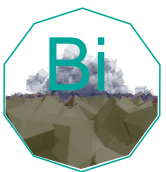Bismuth

Bismuth (Bi)
General Information
- Symbol: Bi
- Atomic Number: 83
- Atomic Weight: 208.98040 u
- Element Category: Post-transition metal
- Group: 15
- Period: 6
- Block: p-block
Physical Properties
- Appearance: Silvery-white with a pink tinge
- Density: 9.78 g/cm³
- Melting Point: 271.4 °C (520.5 °F)
- Boiling Point: 1564 °C (2847 °F)
- Phase at STP: Solid
- Electron Configuration: [Xe] 4f¹⁴ 5d¹⁰ 6s² 6p³
- Oxidation States: +3, +5 (most common)
Chemical Properties
- Reactivity: Bismuth is relatively stable and resists oxidation. It forms various compounds, particularly with oxygen and sulfur.
- Compounds: Forms compounds such as bismuth trioxide (Bi₂O₃), bismuth subcarbonate (BiO)₂CO₃, and bismuth chloride (BiCl₃).
Uses and Applications
- Medical: Bismuth compounds, like bismuth subsalicylate, are used in medicines for treating gastrointestinal disorders.
- Cosmetics and Pigments: Used in cosmetics and pigments due to its non-toxicity and bright colors.
- Alloys: Bismuth is used in alloys with a low melting point, such as those for fire detection and suppression systems.
- Electronics: Used in semiconductors and in the production of lead-free solder.
- Nuclear Industry: Utilized as a coolant in nuclear reactors and in the production of heavy metal shielding.
Occurrence and Extraction
- Natural Occurrence: Found primarily in minerals such as bismuthinite (Bi₂S₃) and bismite (Bi₂O₃).
- Extraction: Extracted from bismuthinite through processes involving roasting and reduction with carbon.
Isotopes
- Stable Isotopes: Bismuth-209 (previously thought to be stable but now known to be very weakly radioactive with an extremely long half-life).
- Radioactive Isotopes: Several isotopes used in scientific research and medical applications, including Bismuth-210 and Bismuth-213.
Safety and Handling
- Hazards: Bismuth is considered non-toxic and is one of the least toxic of the heavy metals. However, some bismuth compounds can be harmful if ingested or inhaled.
- Precautions: Handle with appropriate protective equipment to avoid inhalation or ingestion of dust or fumes.
History
- Discovery: Known since ancient times, but often confused with lead and tin. Claude François Geoffroy identified bismuth as a distinct element in 1753.
- Name Origin: The name “bismuth” is derived from the German word “Wismut,” meaning white mass.
Additional Facts
- Crystal Structure: Rhombohedral
- Magnetic Properties: Diamagnetic
- Thermal Conductivity: Low, about 7.97 W/m·K
- Electrical Resistivity: High, about 1.29 μΩ·m at room temperature
Summary
Bismuth is a post-transition metal known for its stability and non-toxicity. It has significant applications in medicine, cosmetics, alloys, electronics, and the nuclear industry. Found primarily in minerals like bismuthinite and bismite, bismuth is extracted through roasting and reduction processes. Despite its heavy metal status, bismuth is one of the least toxic elements in this category, making it valuable in various industrial and commercial applications.
40 Question and Answer Pairs About Bismuth
What is the atomic number of Bismuth?
- 83
What is the symbol for Bismuth?
- Bi
What is the atomic weight of Bismuth?
- 208.98040 u
In which group of the periodic table is Bismuth found?
- Group 15
What period is Bismuth in?
- Period 6
What block does Bismuth belong to?
- p-block
What is the melting point of Bismuth?
- 271.4 °C (520.5 °F)
What is the boiling point of Bismuth?
- 1564 °C (2847 °F)
What is the density of Bismuth?
- 9.78 g/cm³
What is the electron configuration of Bismuth?
- [Xe] 4f¹⁴ 5d¹⁰ 6s² 6p³
What are the common oxidation states of Bismuth?
- +3, +5
What is the appearance of Bismuth?
- Silvery-white with a pink tinge
Is Bismuth reactive with air?
- Bismuth is relatively stable and resists oxidation.
Name a compound of Bismuth.
- Bismuth trioxide (Bi₂O₃)
What is a common use of Bismuth in medicine?
- Used in medicines like bismuth subsalicylate for treating gastrointestinal disorders.
How is Bismuth used in cosmetics?
- Used in pigments due to its non-toxicity and bright colors.
What role does Bismuth play in alloys?
- Used in low melting point alloys for fire detection and suppression systems.
How is Bismuth used in electronics?
- Used in semiconductors and lead-free solder.
What application does Bismuth have in the nuclear industry?
- Utilized as a coolant in nuclear reactors and in heavy metal shielding.
Name a mineral that contains Bismuth.
- Bismuthinite (Bi₂S₃)
How is Bismuth extracted from ores?
- By roasting bismuthinite and reducing it with carbon.
What is the most stable isotope of Bismuth?
- Bismuth-209
Name a radioactive isotope of Bismuth used in medical applications.
- Bismuth-213
What safety hazard is associated with Bismuth compounds?
- Some compounds can be harmful if ingested or inhaled.
Who identified Bismuth as a distinct element?
- Claude François Geoffroy
Where does the name Bismuth come from?
- From the German word “Wismut,” meaning white mass.
What is the crystal structure of Bismuth?
- Rhombohedral
Is Bismuth paramagnetic or diamagnetic?
- Diamagnetic
What is the thermal conductivity of Bismuth?
- About 7.97 W/m·K
What is the electrical resistivity of Bismuth at room temperature?
- About 1.29 μΩ·m
What is the primary oxidation state of Bismuth?
- +3
Is Bismuth found as a free element in nature?
- No, it is found in minerals like bismuthinite and bismite.
What is the common name of bismuth subcarbonate?
- (BiO)₂CO₃
What is a major application of bismuth chloride (BiCl₃)?
- Used in chemical synthesis and research.
How does Bismuth benefit medical applications?
- It is used for its non-toxicity and effectiveness in treating gastrointestinal disorders.
What is the boiling point of Bismuth in Kelvin?
- 1837 K
What group does Bismuth belong to in the periodic table?
- Post-transition metals
What is the natural abundance of Bismuth-209?
- Nearly 100%
Can Bismuth be used in high-temperature applications?
- Yes, in certain specialized high-temperature alloys.
What precaution should be taken when handling Bismuth compounds?
- Handle with appropriate protective equipment to avoid inhalation or ingestion.






